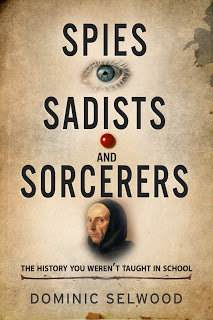Nancy Bilyeau interviews him on her blog, highlighting his revisionist view of the English Reformation, which certainly coincides with mine (and hers, too, I think).
Selwood's website provides generous excerpts from the book, including this "unintended Reformation" moment, discussing Walpurgisnacht and the saint it should be honoring:
It is pure coincidence that Walburga was canonized on May Day, thus giving her name to the festivities of the night before. But it is also strangely fitting, as popular belief in the healing properties of saints’ relics (and oils) is inseparable from our historical attachment to magic.
And here is where something fascinating happens. As the Reformation swept away faith in popular and largely benign Christian miracles, it instead offered belief in a much darker magic —one that would quickly lead to the horror of the witch-craze and fantastical legends like the sabbaths on the Brocken.
It is deeply ironic that the Protestant reformers, in abolishing what they saw as harmful superstitious claptrap, replaced it with terrifying magical fears that would end with the brutal and pointless murder of tens of thousands of innocent women.
Before the Reformation there had, of course, been some scattered witch trials. But the same reforming theologians who lambasted what they saw as the crude and irrational magical beliefs underpinning the cult of saints and relics rapidly convinced themselves that hundreds of towns and villages were sheltering the foulest witches and demons, whose unnatural rites jeopardized the health and salvation of Christendom. They saw them flying on diabolical beasts, covering vast distances in the blink of an eye. They found on them folds of skin used for suckling demons in the form of familiars. They accused them of sexually molesting decent folk, invading their beds as lustful incubi and succubi. They were convinced they possessed infernal powers to see the past, the present (at great distance), and the future. But above all, they feared the witches were working ceaselessly to destroy their new, rational churches.
As the reformers set about ridding the world of these devilish handmaidens, the great burnings began, peaking in the late 1500s and early 1600s, before petering out in the early 1700s. In that time, somewhere between 40,000 and 100,000 people (predominantly, but not exclusively, women) were torched alive on suspicion of practising magic.
Looks like a fascinating, if episodic, review of events in history seen from different angles.

I seem to remember reading somewhere that the Inquisition authorities were able to see thru this madness, and had very little to do with crusading against “witchcraft."
ReplyDeleteI've mentioned that in the past, informed by an old BBC documentary: http://supremacyandsurvival.blogspot.com/2014/08/the-bbc-exposes-myth-of-spanish.html
Delete